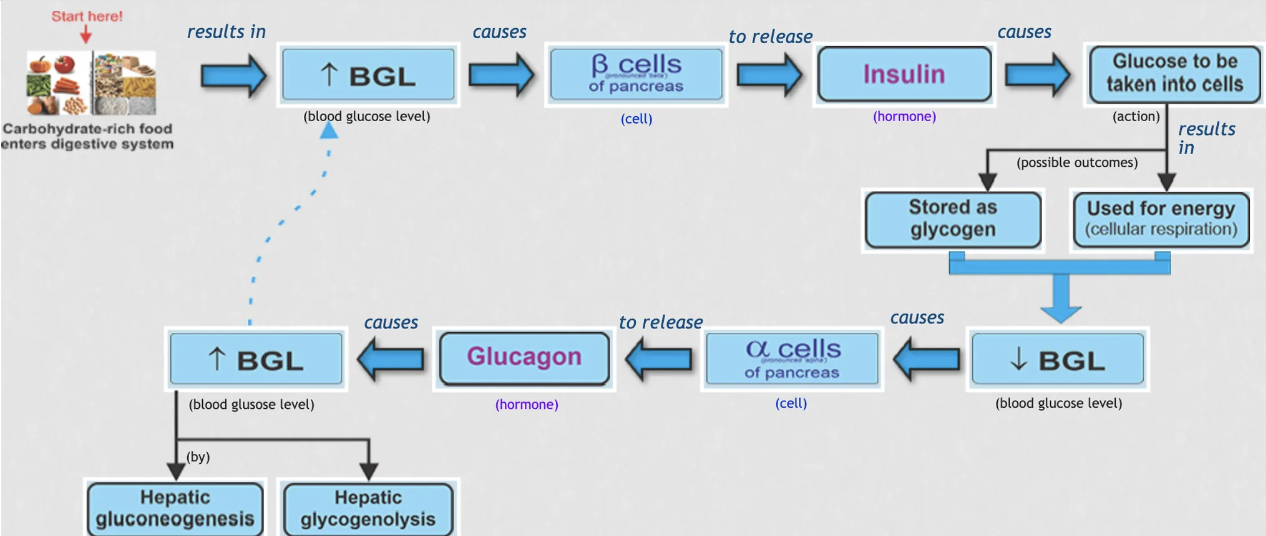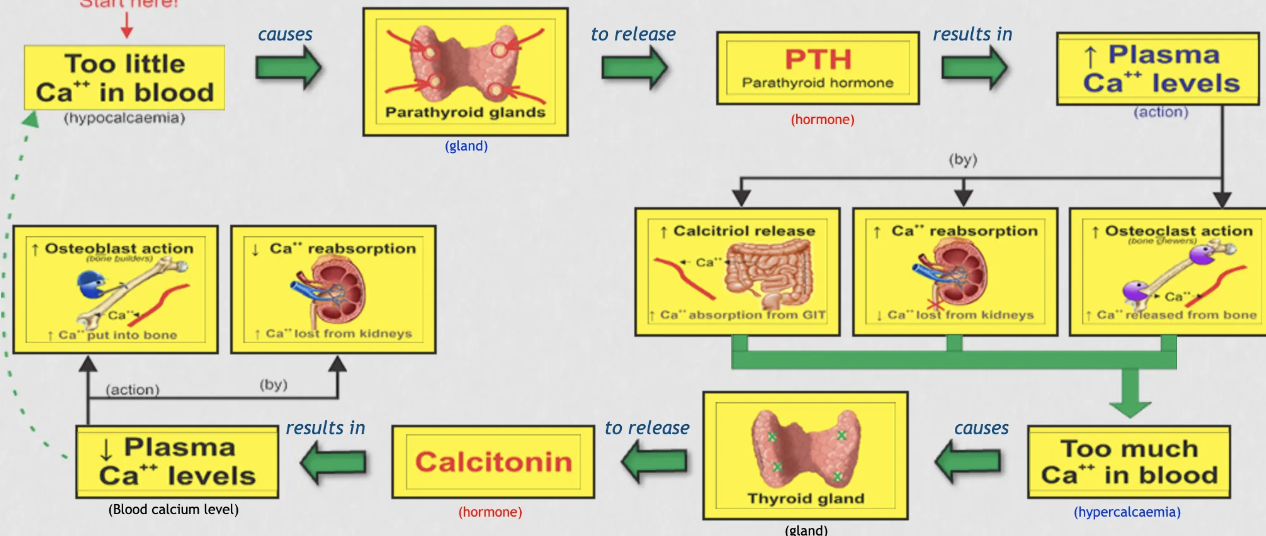biol121 - week 5
1/31
There's no tags or description
Looks like no tags are added yet.
Name | Mastery | Learn | Test | Matching | Spaced |
|---|
No study sessions yet.
32 Terms
endocrine system
the endocrine system coordinates functioning between different organs through hormones, which are released into the bloodstream from specific types of cells within endocrine (ductless) glands. once in circulation, hormones affect function of target tissue, which may be another endocrine gland of an end organ
endocrine
hormones
secretion direct to bloodstream
no ducts
insulin and glucagon
excocrine
secretion into epithelial surfaces
via ducts
sweat, mucus, digestive enzymes
what does the endocrine system do?
regulate growth
controls reproduction (pregnancy and menopause)
regulates sleep
allows body to cope with stress, trauma and infection
regulates circulation and red blood cell production
controls digestion and absorption of food
hormones
blood borne chemical messenger, specific target, low concentration
hormones bind to receptors
receptors
specialised proteins in or on cells) are located in: the cell membrane, cytoplasm and nucleus
target cell - when specific receptors are present
each cell can respond to w wide variety of hormones, wide variety of receptors
determines hormone sensitivity and functionality of the tissues
water soluble hormones
interacts with receptors on/in cell membrane
effects are ‘indirect’ (via second messenger systems)most hormones (insulin, PTH, adrenaline)
fat soluble hormones
can easily cross the cell membrane
interacts with receptors inside cell
effets are ‘direct’
cortisol, aldosterone, sex hormones, vitamin D, thyroid hormone
mechanisms of action
rates of enzymatic reaction: change shape and function of the enzyme
controlling transport: open/close membrane channel
controlling gene expression: turn on/off, increase/decrease rate of protein production
communication
commands from endocrine and nervous system, communicate and control with other, endocrine uses chemical messengers - hormones and the nervous system uses nerve impluses
hypothalamus
command centre of endocrine system
nervous system and endocrine intercept - structurally connected
highest level of endocrine control in the body
hypothalamus can produce own hormones - in nerves stored and released to the posterior pituitary
anterior pituitary
makes and releases OWN hormones
lots of hormones
connection via capillary beds
hypothalamus release hormones (releasing or inhibiting), travels down through blood vessel to bind to receptors in AP, stimulates and produces own hormones into the bloodstream
posterior pituitary
stores and releases hormones made by the hypothalamus
two hormones
connections via nerve fibres
specialised nerves sitting in the hypothalamus that released hormones, not direct blood connection, hormones travels down axons on nerves then stored and released in the posterior pituitary
connected to hypothalamus via direct nervous connection or hormonal signals secreted by the anterior pituitary hormones
hormones in posterior pituitary
oxytocin (OT): controls uterine contractions at onset of labour, controls milk release from lactating breast
anti-diuretic (ADH) hormone: acts on kidneys to reabsorb water, regulates blood osmolarity, aka vasopressin
thyroid gland
sensory inputs from the environment
releasing RH (releasing = go signal) and inhibiting IH (inhibiting - stop signal) hormones from the hypothalamus control release of anterior pituitary hormones = TSH - thyroid gland
thyroid gland cont
butterfly shaped organ
two hormones
thyroid hormones: TH, (T3, T4/thyroxine) - how many iodine atoms are apart of that structure, converts iodine in thyroid hormones
need iodine
calcitonin
decrease blood calcium
thyroid gland functions
increase basal metabolic rate
increased metabolic rate means increased heat production
stimulate protein synthesis and usage of fuels to make ATP
enhanced sympathetic activity (increased HR and BR)
essential for normal growth and development (especially skeletal and nervous system)
negative feedback system
thyroid gland steps
hypothalamus secretes hormone - pituitary gland, which tells anterior pituitary gland to secrete a second hormone and release it into the blood stream
hormone - bloodstream - thyroid gland, when it binds to a receptor = causes the thyroid gland to produce and release the thyroid hormones - affecting metabolism, growth and development
adrenal gland
essential for life
superior to kidney
paired glands
to regions: cortex and medulla
hypothalamus controls the adrenal gland function - secretion of regulatory hormones to control activity of the anterior lobes of the pituitary gland & control of sympathetic output to adrenal medulla
is a modified part of the SNS that secretes adrenaline and nor adrenaline
metabolic effects and CVS effects of adrenal medulla
increases amount of energy for immediate use:
glycogenolysis: releases glucose
lipolysis
increases cardiac output (increase HR and SV)
vasodilation of coronary and skeletal muscle blood vessels
bronchodilation
vasoconstriction of blood vessels to non-essential tissues (GIT, skin, kidneys)
glucose homeostasis
our cells use glucose to produce ATP and our cells use ATP to power important biological functions
protein synthesis. muscle contraction, nerve impulse transmission
the brain consumes LOTS of glucose derived energy
absorption: glucose is out gut has been absorbed across the gut wall into the bloodstream
pancreas is key
glucose is regulated by - insulin, glucagon and other hormones
HYPERglycemia
after you eat:
blood glucose INcreases
INsulin is released: decrease blood sugar levels
beta cells produce insulin
usage and storage
HYPOglycemia
HYPOglycemia
when you are fasting
blood glucose decreases
glucAgon is released (alpha cells): raises blood sugar levels
releases stores
make new glucose
glucose homeostasis steps
increase in blood glucose levels: b cells of the pancreas release insulin and this causes glucose to be taken into cells to be stored as glucagon or used for energy (cellular respiration) - decrease in blood glucose levels
decrease in blood glucose levels: cause alpha cells to release glucagon and this increases blood glucose levels by hepatic gluconeogenesis (make new glucose) and glycogenolysis (break down glycogen to glucose)

glucose homeostasis terms
glucose: a simple sugar
glucagon: hormone to increase BGL
glycogen: stored glucose
gluconeogenesis: make new glucose
glycogenolysis: break glycogen (to glucose)
calcium homeostasis
calcium is important in many physiological processes
structural component of bones and teeth (99%)
maintains normal excitability of nerve and muscle cells
muscle contraction (skeletal and cardiac)
co-factor in many important reactions
milk production
calcium metabolism regulated by
parathyroid glands are key
parathyroid hormone (PTH)
vitamind D (calcitriol)
calcitonin (minor significance in adult humans and more relevant in growing individuals)
HYPOcalcemia
lower than normal
factors that increase blood calcium level
parathyroid glands release PTH
oestoclasts release calcium from the bone
calcium is reabsorbed from urine by the kidney’s
calcium absorption in the small intestine increases via vitamin D synthesis
HYPERcalcaemia
too high
factors that decrease blood calcium level
thyroid gland releases calcitonin
osteoclast activity is inhibited and increased osteoblast action
calcium reabsorption in the kidneys decreases
calcium level in blood decreases
calcium homeostasis steps
increase in calcium blood levels - increase calcitonin by thyroid - decrease osteoblast activity, decrease bone clearance, increase calcium secreted from the kidney’s = decrease in calcium blood levels
decrease in calcium blood levels - increase in PTH (parathyroid hormone) - increase in osteoclasts, increase bone clearance, increase calcium reabsorption from kidneys, increase calcium absorption into GIT
osteoclasts: cut, break down calcium to get calcium for bone clearance
osteoblasts: build calcium

oxytocin: positive feedback loop
contraction of the uterus: changes in homeostatic balance
stretching of the cervix = change monitored by the stretch receptors in the cervix, which sends details of change to the hypothalamus, this integrates signals, processes and sends instructions, the hypothalamus releases the oxytocin
muscle sin the uterus walls contract and the presence of a baby stretch the cervix more = more chemicals and increase stretching of the cervix
this positive feedback loop amplifies stimulus, until the presence of the stimulus is no longer there
TRH and TSH - negative feedback loop
cold infant with low metabolic rate
THR is released by the hypothalamus and arrives at the anterior pituitary which stimulates the production of TSH at the anterior pituitary, which then activates T4 and T3 at the thyroid this then affects
metabolic rate, heat production, enhancement of growth, CNS development, enhancement of SNS at muscles, adipose tissue, liver and the heart
this negative feedback counteracts the stimulus and returns the body to homeostasis